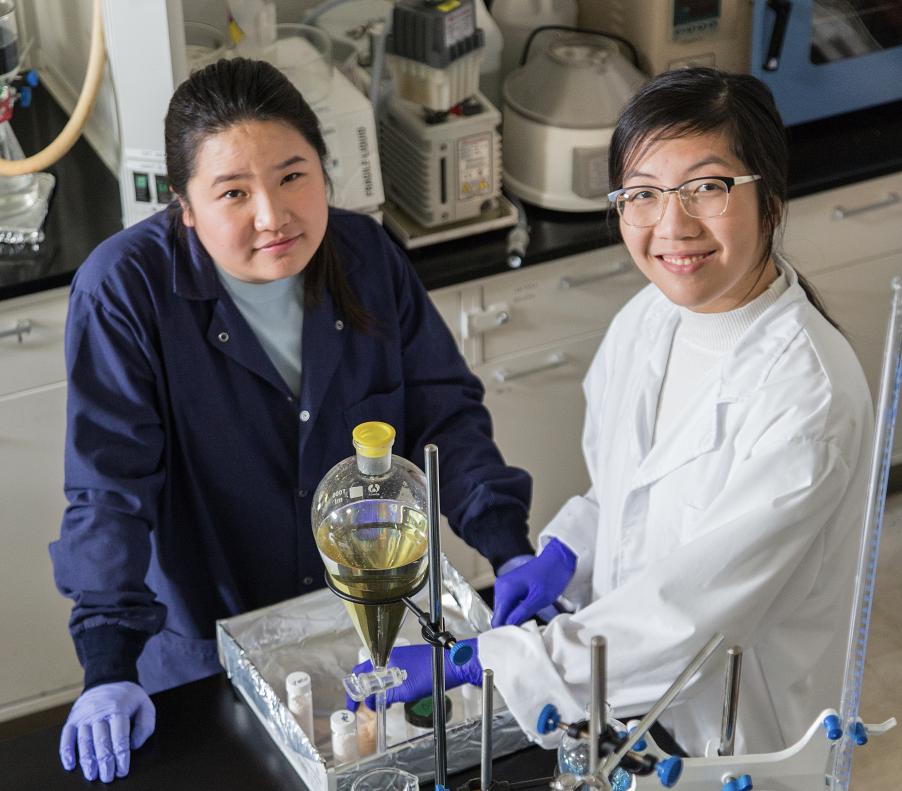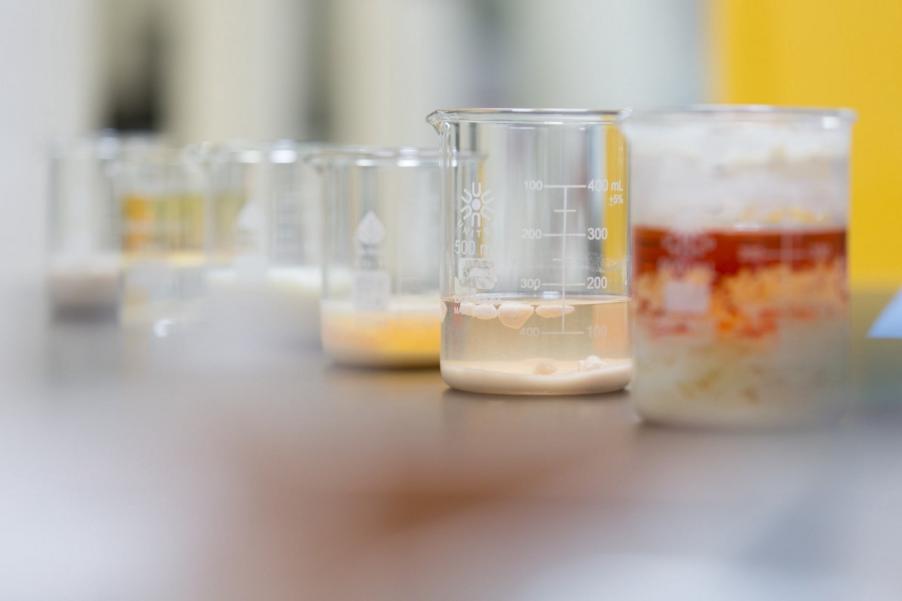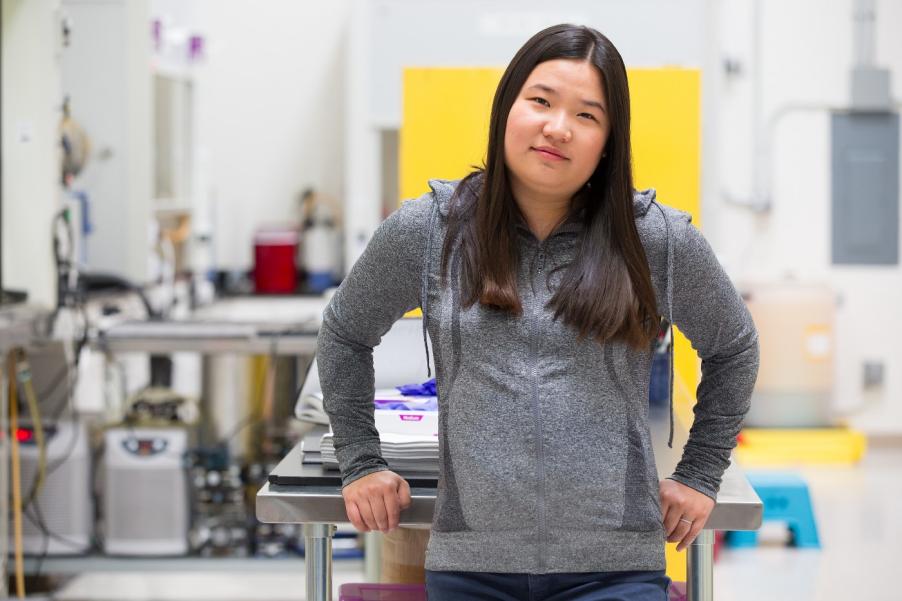Meet the Best Friends Revolutionizing Recycling
The two scientists behind trailblazing tech company BioCellection fell in love with the plastic problem and took it on together.
The two scientists behind trailblazing tech company BioCellection fell in love with the plastic problem and took it on together.


Throughout high school, Miranda Wang and Jeanny Yao spent Friday afternoons hanging out with their school’s waste. Alongside a dozen other students in the Vancouver school’s recycling club, they sorted countless juice boxes and soda bottles. They scrubbed the residue off bins. It was, in a word, “disgusting.”
Recycling seemed like the antidote for our plastic waste epidemic. The two friends believed it was “the best thing that we, as stewards of the planet, could do.”
Twelve years later, they remember the moment they discovered the recycling system’s not-so-little dirty secret. The summer after 10th grade, they toured a local waste transfer center on a field trip. Inside the sprawling three-story building sat a monstrous pit that looked the size of a football field. From the control room, a pickup truck dropping off materials on the side of the pit looked like a speck — a barnacle on a barge of waste.
The hard truth: recycling wasn’t working. In fact, hardly any of the junk in the pit—including countless juice boxes and soda cans—would be recycled. The workers would divert what they could, they said, but the rest was off to the landfill. It’s estimated only nine percent of plastic is recycled.
That summer, Miranda’s optimistic lens on life was challenged. “As kids you imagine that the adults have it all figured out, the adults will take care of the world,” she said. “I realized that the world is not as put-together as I imagined. There were no people or intricate machines taking this [waste] apart on the back of the stage…the afterlife of plastics was so unjust.”
“We’ve been lied to by adults for our whole lives,” she thought.
Tossing trash into the right bin would never solve the root problem. No one had developed the necessary kind of solution: a circular economy where all plastic waste — and not just the cleanest stuff — would become valuable in the long-term.
Today, the 25-year-old best friends still work on the front lines of sustainability. But after glimpsing the plastic problem’s true scale, they went after the system that had undercut their early efforts.
Miranda and Jeanny found each other in eighth grade — whether they met in band, math class, or the recycling club, neither knows for sure. They shared the same altruism and idealism, convinced that science and technology could solve just about anything. In 11th grade, they became co-presidents of the recycling club, and created the school’s first organic garden and composting system.

Best friends and scientists Miranda Wang and Jeanny Yao. ©Rolex/Bart Michiels
The friendship “has allowed us to stay true, individually and collectively, to what we believe in,” they say. “We kind of complete each other.”
The friendship naturally doubled as a partnership. Jeanny’s attention to detail and Miranda’s big-picture vision served as natural complements.
Miranda is the fearless, visionary type who can portend innovations years in advance, but gets jumpy when she feels the “aftershock” of the idea under her feet. That’s when Jeanny assures her that they can — and will — be able to put their ideas into action.
During their senior year of high school, Miranda recruited Jeanny to a project for a biotechnology science fair. They spent 11 straight hours reading academic papers in Starbucks, preparing to put together a research proposal and enter Canada’s most prestigious student biotech competition.
The project — a first attempt at solving the plastic problem — was inspired by bacteria. They collected soil samples from along the nearby Fraser River and, with support from researchers, conducted lab experiments to figure out whether these bacteria could survive on plastic waste.
The results were exciting: they found a bacteria that could, in fact, eat plastic. (And it’s not the only one). They were named finalists for the award. And a year later, the pair found themselves on the TED stage, trimmed in black-and-white business attire, presenting their findings.
“Did you know that an apple core takes only three weeks to degrade, while a plastic carton takes at least one hundred years to do the same?” Miranda opened the talk from the middle of the stage, as Jeanny stood stoically at her side.
“Imagine a world where all plastic waste will decay in just a few days,” Miranda continued, with TED-stage gusto. “Picture yourself sprinkling bacteria powder into your trash as you take it out for weekly pickup. And then three days later, when you come to your garbage can, you’ll notice that this plastic waste has been broken down, eaten by this magical bacteria!”
Except they would soon discover that this “magical” bacteria was no match for the scale of the plastic problem. “Using biology to deal with trash,” Jeanny explains, “is just a very complicated and very slow process.”
What appeared a setback was actually a breakthrough. Perhaps, Miranda and Jeanny thought, if the bacteria’s cells can find biological ways to break down plastics, there are chemical ways to do the same thing— only faster.

In the BioCellection laboratory, beakers show the different stages in the transformation of plastic. ©Rolex/Bart Michiels
While working to develop this process in the lab, the two friends found themselves pursuing science at colleges in different countries. A year before graduation, they spent a summer at a business accelerator in a tiny Ireland town. Far away from everything familiar, they spent late nights anxiously contemplating what to do next. Miranda flew out to Silicon Valley for answers. Staying in a somewhat sketchy Air BnB, she took every appointment she could.
They decided to go for it. At age 21, the newly-graduated friends moved to California and co-founded BioCellection, a start-up now leading a recycling revolution.
Rather than only using plastics to make more biodegradable products (think coffee sleeves or eco-friendly packaging), BioCellection’s six-hour chemical process invention breaks down plastics into valuable chemicals that can serve as building blocks for high-quality performance goods — everything from cars to clothing to buildings.They’re the first to create a type of very versatile chemical building blocks (called dicarboxylic acids) from plastic — not petroleum or shale.
Another first: BioCellection is using city trash from households and companies, instead of just clean plastics. The process uses previously “unrecycleable” polyethylene plastics — especially post-consumer films used in grocery bags, bubble wrap, food wrap, and packaging. Currently, they achieve over 70% conversion from plastic waste material to chemical intermediates — a rate they’re working to improve.
Now a team of 11 based in Silicon Valley, BioCellection is scaling up to a processing plant that would have the capacity to recycle 300 tonnes per year of formerly unrecyclable plastic by 2025. This will serve as their demonstration to then scale to commercial facilities rapidly around the world. The goal: create a circular economy — a system where plastic waste resurrects as long-lasting products, rather than reincarnating as merely more friendly disposables.
What sets BioCellection apart from other recycling solutions is its potential to transform the system itself.
Abreakthrough this big attracted international attention. Rolex named Miranda a 2019 Laureate for the Rolex Awards for Enterprise; her image now appears in full-page magazine ads. Elle Magazine named Miranda and Jeanny among the “27 Women Leading the Charge to Protect Our Environment.” The two have appeared in other publications and short films.

Miranda Wang pitches BioCellection at the 2019 Ashoka and QBE Urban Resilience Challenge. ©Sarah Holcomb/Ashoka
In October 2019, Miranda pitched BioCellection at the Ashoka and QBE Urban Resilience Challenge in New York, achieving the “Urban Resilience Pioneer” award —a $25,000 prize to help fund their work.
The commercial appeal of the solution had become clear back in the early days of studying plastic-eating bacteria from the Fraser River. Before hitting the TED stage, Miranda and Jeanny had presented at the Sanofi BioGENEius Challenge Canada, where their idea was deemed to have “the greatest commercial potential” and received a 10 million dollar evaluation.
Today, among BioCellection’s supporters is Schmidt Marine Technology Partners (founded Wendy Schmidt and Eric Schmidt, the ex-Chairman of Alphabet). The start-up is partnering with waste collection and recycling companies — such as Greenwaste Recovery — and city governments like San Jose — as well as brands to form their supply chain.
With a larger-than-life vision, bold technology, and young leadership, perhaps it isn’t surprising that the two landed in Silicon Valley. Adapting to the landscape of big tech would take some adjustment, however, as they moved out of the academy into the world of business. To pitch investors, the pair needed to know exactly who they were, the problem, and what made their solution special. That confidence didn’t develop overnight.
But they also knew that now that corporations were starting to listen up. As China is no longer accepting the bulk of the U.S.’s unwanted plastic waste, the country’s companies need a radical solution for the plastic problem more urgently than ever before.
Miranda’s view of history is surprisingly sympathetic to modern industry’s predicament. In the grand scheme of human civilization, she says we needed an era to extract from an abundant source — like fossil fuels—to make modern materials for a growing population. But the end of that era was equally inevitable.
The amount of plastic manufactured in the first ten years of this century surpassed the total produced in the last century. It’s led to the pollution of our land, water, and air, a loss of wildlife, and climate change.
The pair argue that the future will not be fueled by oil, but powered by plastic. With advances in chemistry, plastic waste will become easier to process, and in 50 years they project that we’ll be mining landfills as a major resource.
This vision extends beyond North America— “globally, we want to empower the people who are suffering from plastic pollution,” Jeanny says. When plastic waste becomes valuable, new paths to income and employment open up for communities around the world, as these materials become increasingly important for manufacturing.

Miranda Wang at the BioCellection offices in Menlo Park, California. ©Rolex/Bart Michiels
Miranda and Jeanny refuse to let a conversation, even a scientific one, take place only at the molecular level. The pair knew that the world didn’t need a new kind of biodegradable packaging — the system needed to work differently.
“The circular economy will be established in this generation,” Miranda says. “I’m absolutely sure of that.”
Even over the static, it’s impossible to miss the urgency in her voice. The two friends were on the road as we spoke, en route to film a documentary about their work in Canada. The film, produced by an independent director, is “trying to inspire and empower young people to solve these huge environmental problems that are making people feel pretty hopeless,” Miranda explains.
Miranda and Jeanny know what it’s like to take on these huge problems at a young age. Now they were revisiting the places and people that had influenced their journey as innovators. They stopped at their high school, where they had persuaded the principal for a plot of school land and worked every weekend for six months to build garden beds and a compost system.
As their technology developed, the friends also underwent change, from navigating their teenage years, to meeting significant others, to making cross-country moves. The latest frontier: adjusting to life as young working professionals in California.
This relationship has grounded them during the grind, like when they receive a harsh assessment from a would-be investor. “We can always point to something we’ve overcome together in the past,” Miranda says — “Remember that moment that was super scary or uncomfortable — remember how we were able to get over it?”
As students, they sometimes felt they weren’t taken seriously. At the same time, they used age to their advantage — a chance to learn and surpass expectations.
Since eighth grade, their views on the environment have evolved together. As students, Miranda and Jeanny believed that they could protect the planet if people just put things in the right bins. Then they discovered just how messy the plastic waste problem is.
BioCellection’s technology is part of a fundamental shift. Around the world, students are mobilizing to protect the environment; they’re organizing climate strikes, developing science fair projects, and leading green movements. Our next big breakthrough might be developing in a high school laboratory.
As for the recycling clubs of the future, students will probably be less focused on sorting soda cans. Instead, they’ll be working together to imagine how we can redesign our world, using plastic waste.
-
Miranda Wang and Jeanny Yao were finalists in the 2019 Ashoka and QBE Urban Resilience Challenge. (Learn more about BioCellection here)